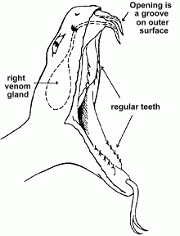Hear a rattlesnake warning rattle here. Ground-nesting birds and eggs are also eaten by some rattlers. Rattlesnakes can consume about 40% of their own body weight. Rattlesnakes have heat-sensing organs on their heads. These facial pits enable rattlesnakes to seek out and strike, even in darkness, warm objects such as small animal prey. The eyes, which have vertically elliptical pupils, or "cat eyes," are also a characteristic of rattlesnakes.  Just before it strikes, the fangs become fully erect at the outer tip of the upper jaw. The fangs are hollow, and act like hypodermic needles to inject the venom into the prey. Rattlers cannot spit their venom, but venom can be squirted out if it strikes at a stick or other hard object. Rattlesnakes can regulate the amount of venom they inject when they strike. After striking a small rodent, the rattlesnake releases its prey, and follows it until it dies. Illustrated here are the fangs from a Western Diamondback (large) and an Ontario Massasauga rattler (small). Mature fangs are shed several times a season. They can be lost by becoming embedded in the prey. When a fang is lost, it will soon be replaced by another; spare fangs are located directly behind one another in the sheath at the roof of the mouth. All snakes also have many small teeth in both the upper and lower jaws. These teeth, which curve backwards, don't chew or tear food, but hold the food, and help with swallowing. A snake swallows its prey whole, flexing its jaws and moving its whole mouth around the prey. See pictures of a Timber Rattler striking and swallowing a mouse. Breeding season for rattlesnakes lasts about 2 months in the spring, when they emerge from hibernation. The young are born in the fall. Rattlesnakes may not produce young every year. Female rattlesnakes produce eggs, which grow and hatch inside the mother's body. The young, anywhere from 5 - 12 of them, are 15 - 20 cm long when born, and have a single rattle (called a button), fangs, and venom. They can strike within minutes, but being so small, are not dangerous. Rattlesnakes mature in about 3 years. Rattlesnakes hibernate during the winter. They may hibernate alone, or in small groups, or, if a large den is available, in large groups of several hundred. All dens must be deep enough so the temperature is not affected by occasional warm days. If not, the snakes might emerge too early in spring, and become vulnerable if the weather turns cold. (Since snakes are coldblooded and their body temperature is altered by air temperature, cold weather makes them sluggish). Rattlesnakes coil for protection, and shake their rattles as a warning, but they can strike only from a third to a half of their body length. Rattlesnakes are aggressive if exposed to warm sunshine. Since they have no effective cooling mechanism, they may die from heat stroke if kept in the sun on a hot day for more than half an hour or so; they need to find shade to stay cool. The Eastern Massasauga Rattler They are fairly common on the Bruce Peninsula and the eastern shoreline of Georgian Bay, in Ontario. This snake is protected in Ontario, but its numbers are declining because of loss of habitat and killing by humans. Young Massasaugas feed on other snakes; adults eat mainly small rodents and frogs. This snake is a sluggish, solitary and passive creature. It prefers to remain motionless, hoping not to be noticed. If you come too close, it will rattle a warning. They never pursue people, and would rather flee than fight. They have a short striking distance, only about half their body length, or about 38 cm. The Western Diamondback Rattlesnake The venom of the Western Diamondback Rattlesnake is complex mixture of poisons, which cause tissue damage and hemorrhaging in humans. Anti-venom is made using the venom from the snakes themselves, so snakes must be captured and 'milked' of their venom. Large Western Diamondback rattlesnakes can be milked every two weeks, and give 1 ml of venom. The Western Diamondback inhabits the lower United States and Mexico. It can survive on mountains up to altitudes of 8000 ft, the seacoast, inland plains, desert areas, and are also found in regions of heavy timber. The Western (Prairie) Rattlesnake The color of the Prairie Rattlesnake varies from light brown to green, with a yellowish belly. Adults are about a metre long, but larger ones have been spotted. |